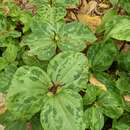en
names in breadcrumbs


Many color forms occur and have been named. In forma luteum J. D. Freeman, for example, all floral organs lack purple pigment, and the petals are clear, soft yellow, whereas forma simulans J. D. Freeman has yellow petals with purple bases, and purple stamens and carpels. These are illustrated in color in F. W. Case and R. B. Case (1997).
Trillium maculatum, the spotted wakerobin or spotted trillium,[4][5] is a species of flowering plant in the family Melanthiaceae. It is a member of the Trillium cuneatum complex, a closely-related group of sessile-flowered trilliums. The species is endemic to the southeastern United States, ranging across Alabama, Georgia, South Carolina, and northern Florida.
Trillium maculatum is a perennial, herbaceous, flowering plant that persists by means of an underground rhizome. Like all trilliums, it has a whorl of three bracts (leaves) and a single trimerous flower with three sepals, three petals, two whorls of three stamens each, and three carpels (fused into a single ovary with three stigmas).[6] It has a sessile flower (no flower stalk), erect petals, and mottled leaves.[7] Its flower petals are deep red or reddish-purple but occasionally yellow.[5]
Trillium maculatum was first described by Constantine Samuel Rafinesque in 1830.[2] The specific epithet maculatum means "spotted",[8] a reference to the conspicuously marked leaves of some forms of this species.[9] Although Rafinesque described a species with spotted stems,[10] later authors have not confirmed that character.
Trillium maculatum is a member of the Trillium cuneatum complex, a group of eight taxa including Trillium luteum and Trillium cuneatum (in the strict sense).[11] All members of the complex are sessile-flowered trilliums (Trillium subgen. Sessilia).
Trillium maculatum is endemic to the southeastern United States, ranging across South Carolina, Georgia, Alabama, and northern Florida.[3][12]
Trillium maculatum flowers early February to early April.[13]
Trillium maculatum, the spotted wakerobin or spotted trillium, is a species of flowering plant in the family Melanthiaceae. It is a member of the Trillium cuneatum complex, a closely-related group of sessile-flowered trilliums. The species is endemic to the southeastern United States, ranging across Alabama, Georgia, South Carolina, and northern Florida.